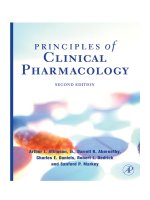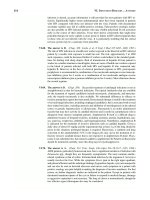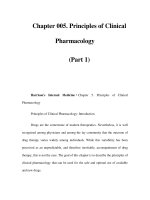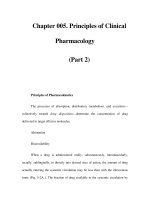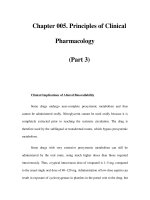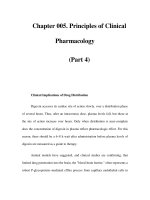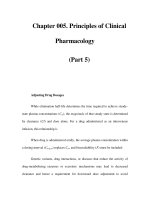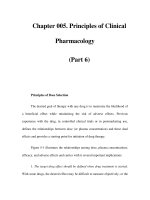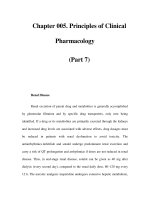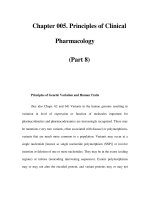Chapter 005. Principles of Clinical Pharmacology (Part 4) ppsx
Bạn đang xem bản rút gọn của tài liệu. Xem và tải ngay bản đầy đủ của tài liệu tại đây (13.5 KB, 5 trang )
Chapter 005. Principles of Clinical
Pharmacology
(Part 4)
Clinical Implications of Drug Distribution
Digoxin accesses its cardiac site of action slowly, over a distribution phase
of several hours. Thus, after an intravenous dose, plasma levels fall, but those at
the site of action increase over hours. Only when distribution is near-complete
does the concentration of digoxin in plasma reflect pharmacologic effect. For this
reason, there should be a 6–8 h wait after administration before plasma levels of
digoxin are measured as a guide to therapy.
Animal models have suggested, and clinical studies are confirming, that
limited drug penetration into the brain, the "blood-brain barrier," often represents a
robust P-glycoprotein–mediated efflux process from capillary endothelial cells in
the cerebral circulation. Thus, drug distribution into the brain may be modulated
by changes in P-glycoprotein function.
Loading Doses
For some drugs, the indication may be so urgent that the time required to
achieve steady-state concentrations may be too long. Under these conditions,
administration of "loading" dosages may result in more rapid elevations of drug
concentration to achieve therapeutic effects earlier than with chronic maintenance
therapy (Fig. 5-4). Nevertheless, the time required for true steady state to be
achieved is still determined only by elimination half-life. This strategy is only
appropriate for drugs exhibiting a defined relationship between drug dose and
effect.
Disease can alter loading requirements: in congestive heart failure, the
central volume of distribution of lidocaine is reduced. Therefore, lower-than-
normal loading regimens are required to achieve equivalent plasma drug
concentrations and to avoid toxicity.
Rate of Intravenous Administration
Although the simulations in Fig. 5-2 use a single intravenous bolus, this is
very rarely appropriate in practice because side effects related to transiently very
high concentrations can result. Rather, drugs are more usually administered orally
or as a slower intravenous infusion. Some drugs are so predictably lethal when
infused too rapidly that special precautions should be taken to prevent accidental
boluses. For example, solutions of potassium for intravenous administration >20
meq/L should be avoided in all but the most exceptional and carefully monitored
circumstances. This minimizes the possibility of cardiac arrest due to accidental
increases in infusion rates of more concentrated solutions.
While excessively rapid intravenous drug administration can lead to
catastrophic consequences, transiently high drug concentrations after intravenous
administration can occasionally be used to advantage. The use of midazolam for
intravenous sedation, for example, depends upon its rapid uptake by the brain
during the distribution phase to produce sedation quickly, with subsequent egress
from the brain during the redistribution of the drug as equilibrium is achieved.
Similarly, adenosine must be administered as a rapid bolus in the treatment
of reentrant supraventricular tachycardias (Chap. 226) to prevent elimination by
very rapid (t
1/2
of seconds) uptake into erythrocytes and endothelial cells before
the drug can reach its clinical site of action, the atrioventricular node.
Plasma Protein Binding
Many drugs circulate in the plasma partly bound to plasma proteins. Since
only unbound (free) drug can distribute to sites of pharmacologic action, drug
response is related to the free rather than the total circulating plasma drug
concentration.
Clinical Implications of Altered Protein Binding
For drugs that are normally highly bound to plasma proteins (>90%), small
changes in the extent of binding (e.g., due to disease) produce a large change in
the amount of unbound drug, and hence drug effect. The acute-phase reactant
1
-
acid glycoprotein binds to basic drugs, such as lidocaine or quinidine, and is
increased in a range of common conditions, including myocardial infarction,
surgery, neoplastic disease, rheumatoid arthritis, and burns. This increased binding
can lead to reduced pharmacologic effects at therapeutic concentrations of total
drug. Conversely, conditions such as hypoalbuminemia, liver disease, and renal
disease can decrease the extent of drug binding, particularly of acidic and neutral
drugs, such as phenytoin. Here, plasma concentration of free drug is increased, so
drug efficacy and toxicity are enhanced if total (free + bound) drug concentration
is used to monitor therapy.
Clearance
When drug is eliminated from the body, the amount of drug in the body
declines over time. An important approach to quantifying this reduction is to
consider that drug concentration at the beginning and end of a time period are
unchanged, and that a specific volume of the body has been "cleared" of the drug
during that time period. This defines clearance as volume/time. Clearance includes
both drug metabolism and excretion.
Clinical Implications of Altered Clearance
